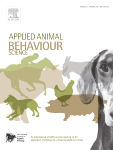Document type: scientific article published in Applied Animal Behaviour Science
Authors: Heidi Mai-Lis Andersen, Anne Grete Kongsted, Malene Jakobsen
Preview: Finding ways to motivate pigs to eliminate in dedicated areas is of major importance for the environment and animal welfare. This review investigates pigs' elimination behaviour and the relation to the rearing environment in addition to identifying important knowledge gaps in this respect. Elimination away from the nest/lying area appears to be innate but evolves over time. Postpartum, piglets eliminate close to the nest, indicating that it is difficult to influence their choice of elimination area, as this is influenced by the sow's choice of nest area. With age, piglets begin to excrete further away from the nest, which seem to be caused by a development in the exploratory and elimination behaviour. There is no indication that the sow directly influences the piglets' elimination behaviour. Elimination frequency decreases with age and is non-uniformly distributed across the day, mainly occurring during daytime following the activity and drinking pattern. There are indications that elimination frequency and time affect the amount excreted per elimination, with a concurrent risk of underestimating the nutrient load during behavioural observations. Regarding the behavioural sequence around elimination, it would appear that sniffing precedes the event and smell is suggested to play a role. However, whether sniffing is related to selection against the use of a specific area for elimination or whether it is a general behaviour in the elimination area cannot be determined. It has been suggested that pigs seek isolation when eliminating, but whether elimination near walls is due to pigs seeking an undisturbed location or is caused by limited pen space cannot be determined either. Neither can it be determined how far away from the nest/lying area pigs are willing to move to eliminate. If there is a limit to how far pigs are willing to move to eliminate, it seems relevant to include several elimination areas in pens with large group sizes. A change in the environment (e.g., location of feed or lying area) changes the pigs' choice of elimination area, although it is individual how well each pig copes. It remains unanswered to which degree the rearing environment influences the elimination behaviour later in life. Future research should focus on the basic elements behind the pigs' choice of elimination area is it simply due to certain areas (e.g. the rest and feeding areas) are deselected or are there elements (e.g. odour, territorial behaviour, undisturbed or upbringing), which motivate and affect the pigs' choice of elimination area. This basic knowledge is needed to understand the background of the elimination behaviour and thus better could focus the effort to manage which area is used as the elimination area.




